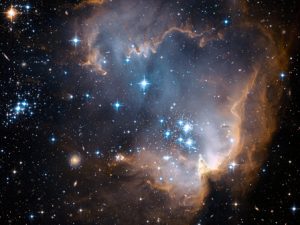Here is Why Star Formation Dwindles with Time
Nearly 11 billion years ago, the universe churned out stars at a rate 10 times greater than today.
Galaxies are made up mostly of hydrogen gas and stars. Hydrogen gas converts to stars with time. Nearly 11 billion years ago, the universe churned out stars at a rate 10 times greater than today.  But the cause of the decline in formation of stars is unknown, mostly because there was no information about the amount of atomic hydrogen gas present at that time.
But the cause of the decline in formation of stars is unknown, mostly because there was no information about the amount of atomic hydrogen gas present at that time.
Scientists have now deciphered the mystery behind this decline by measuring the atomic hydrogen of the galaxies. The measurement of the atomic hydrogen mass of distant galaxies was done by using the upgraded Giant Metrewave Radio Telescope (GMRT) to search for a spectral line in atomic hydrogen.
“Given the intense star formation in these early galaxies, their atomic gas would be consumed by star formation in just one or two billion years. And, if the galaxies could not acquire more gas, their star formation activity would decline, and finally cease”, said AdityaChowdhury, a Ph.D. student at the National Centre for Radio Astrophysics- Tata Institute of Fundamental Research (NCRA-TIFR) and the lead author of the study. “The observed decline in star formation activity can thus be explained by the exhaustion of the atomic hydrogen,” he added.
K. S. Dwarakanath of Raman Research Institute (RRI), a co-author of the study, observes, “We had used the GMRT in 2016, before its upgrade, to carry out a similar study. However, the narrow bandwidth before the GMRT upgrade meant that we could cover only around 850 galaxies in our analysis, and hence were not sensitive enough to detect the signal.”
Unlike stars, which emit light strongly at optical wavelengths, the atomic hydrogen signal lies in the radio wavelengths, at a wavelength of 21 cm, and can only be detected with radio telescopes.
Also Read : Helpline Number Launched for Women in Science
Unfortunately, this 21 cm signal is very weak and difficult to detect from distant individual galaxies even with powerful telescopes like the upgraded GMRT. To overcome this limitation, the team used a technique called “stacking” to combine the 21 cm signals of nearly 8,000 galaxies that had earlier been identified with optical telescopes. This method measures the average gas content of these galaxies.
“The big jump in our sensitivity is due to the upgrade of the GMRT in 2017”, said JayaramChengalur, of NCRA-TIFR, a co-author of the paper. “The new wideband receivers and electronics allowed us to use 10 times more galaxies in the stacking analysis, giving sufficient sensitivity to detect the weak average 21 cm signal” he said.
The team of researchers includes Aditya Chowdhury, Nissim Kanekar, and Jayaram Chengalur of NCRA-TIFR, Shiv Sethi, and K. S. Dwarakanath of RRI. The research paper has been published in the journal Nature.
The research was funded by the Department of Atomic Energy (DAE) and the Department of Science and Technology (DST). (India Science Wire)
